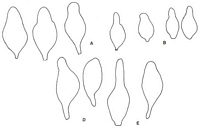|
 Agrocybe howeana Agrocybe howeana
SynonymsAgaricus howeanus
BiostatusPresent in region - Origin uncertain
Images (click to enlarge)
Caption: A. Pleurocystidia PDD 29104; B. Cheilocystidia PDD 29104; D. Cheilocystidia PDD 680; E. Pleurocystidia PDD 680. |
Article: Watling, R.; Taylor, G.M. (1987). Observations on the Bolbitiaceae: 27. Preliminary account of the Bolbitiaceae of New Zealand. Bibliotheca Mycologica 117: 61 p. + 17 pl.
Description: Pileus 25-40-100 mm, hemispherical then plano-convex to plane or slightly gibbous, near pale luteous, then brownish cream, darker towards centre, smooth, dry, becoming cracked, hygrophanous; margin serrate. Stipe (30)50-100 x 3.5-15 mm, equal, ± curved, fragile, annulate, slightly lighter than pileus or buff, darkening below, stuffed then hollow; ring darker buff, superior, fragmentary, when persistent fibrous. Gills free or slightly adnexed, adnate-sinuate, ± crowded, fawn, darker with age to become near umber. Flesh white, thick under pileus-disc. Taste mild; smell disagreeable.
Basidiospores (8-)8.5-9.5 x (5-)6-6.5(-7) µm, ellipsoid-ovoid with smooth, relatively thick wall, brown in both water and alkali; germ-pore present. Basidia 4-spored, 20-23 x 5.5-7.5 µm, clavate. Cheilocystidia mixtures of clavate and ventricose cells, sometimes utriform, 25-38 x 15-20 µm; pleurocystidia prominent, relatively numerous, ventricose, (25-)40-50 x 15-18 µm. Pileipellis a palisadoderm of spheropedunculate cells 13-20.5 µm broad.
Notes: As presently described by Singer (1978) this is a rather broadly conceived taxon and probably will be divided into at least two taxa in the future. As the New Zealand material does not allow detailed examination the above epithet is utilised meantime; the New Zealand material was said to have a mild not a bitter taste, usually a character of A. howeana. It is found not only in North America, from where Peck described it, but also S. America and Central Africa, where it was probably introduced. It should be noted that Peck firstly referred this species to Stropharia because of the purplish tinge to the immature gills; comparison should be made with Stropharia coronilla. A second collection in PDD (solitary, amongst grass on ground, Weraroa, Wellington, 2 X 1919, Cunningham 680) is hesitantly placed here; the pleurocystidia are not as frequent. Some of Cunningham's information is utilised in the description above but because the species is so poorly documented in New Zealand a description of N. American material is offered for comparison:-
Pileus 53-100 mm, convex then expanding, becoming wavy at margin in broad undulations, rich tawny (pale)-straw colour paling to straw yellow at concentrically wrinkled margin, darker but often only slightly so towards disc or in larger basidiomata tawny orange at disc and similar although pale outwards, humid, smooth or fairly rugulose. (One Basidioma with pileus tinged distinct olivaceous buff 'throughout) Stipe 40-68 x 8-13 mm, narrow and relatively thin for size of pileus, swollen slightly at stipe-base to form small bulb with white rhizoidal strands, annulate, pale buff to pallid, irregularly fibrillose-striate below ring, striate at white apex, hollow; ring apical, thin, membranous, soon collapsing onto stipe and then almost disappearing or leaving in age a thin skin from collapsing or after abrasion. Gills buff-pallid with a purple-brown tinge especially when young then becoming snuff-brown. Flesh white in pileus, pinkish brown tinge in stipe downwards, within stipe around 'mid' brown. Taste bitter astringent not mealy (or at most only a hint which is masked and not persistent); smell not mealy, unpleasant but not persistent or penetrating, very earthy, of vegetables immediately on cutting.
In clump; under collapsed Manzanita ( Arctostaphylos sp.) by trackside, Selyer, near Willow Creek, N. California 11 iii 1984, Wat. 17222 in E.
|